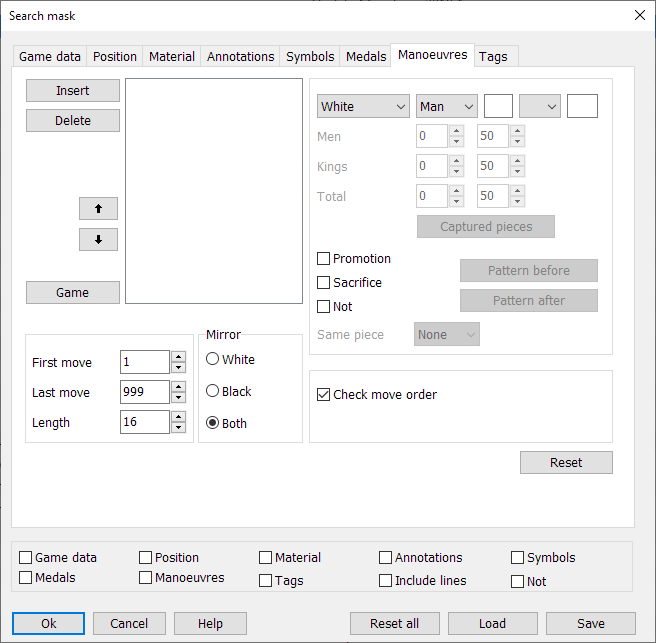Game List | right-click | Find > Manoeuvres
Use this tab to search for manoeuvres.

Insert
To insert a manoeuvre.
Delete
To delete the selected manoeuvre.
Up and down arrows
To change the order of the manoeuvres.
Game
To insert the moves from the Game Window.
When you insert a manoeuvre it looks like "wM?????". It is build of five elements:
•The first letter is the color to move: w (white), b (black), ? (white or black).
•The second letter is the piece type: M (Man), K (King) or ? (Man or King).
•The third and fourth letter are the begin square. If no begin square is defined it shows two question marks.
•The fifth letter is the type of move: - (normal move), x (capture move), ? (normal move or capture move).
•The last two letters are the end square. If no end square is defined it shows two question marks.
Example
Change White to Black (color to move). Change Man to King (piece type). At the edit box to the right of the piece type enter 46 (begin square). Then to the right of the begin square enter "x" (capture move). Then to the right type 2 (end square).
The manoeuvre is now "bK46x02": search all captures of a black king starting at square 46 and ending on square 2.
Men, Kings and Total
If the manoeuvre is a capture you can specify how many men, kings, or total pieces must be captured.
Captured pieces
If the manoeuvre is a capture you can specify the squares with the captured pieces.
Pattern before
To specify a pattern which must be on the board before the manoeuvre is played.
Pattern after
To specify a pattern which must be on the board after the manoeuvre is played.
Promotion
Specify whether the move should be a promotion.
Sacrifice
Specify if the move is a sacrifice i.e. if the piece doing the move is captured the next move.
Not
Switching this on will retrieve games in which the defined manoeuvre did not occur.
Same piece
To force manoeuvres to be executed by the same piece. You can assign different numbers to the manoeuvres. For example, you have 3 manoeuvres. The first and second manoeuvre should be played by piece A and the third manoeuvre should be played by piece B. Then you assign number 1 to the first and second manoeuvre and assign number 2 to the third manoeuvre. These numbers are represented in the list with [1] and [2] behind the manoeuvre.
First move, Last move, Length
This defines the area of the game in which the program is to search for the manoeuvre in question. The “length” value refers to the maximum number of ply (half-moves) in which the whole manoeuvre must occur.
Check move order
In a manoeuvre over a number of moves you may or may not want to restrict the search to games in which the moves occurred in a specific order.
Reset
Clears the manoeuvres data.
Rows
In stead of begin square and end square you can also specify a row number. The base row (46-50) is R9, the row (41-45) is R8 etc. until the promotion row R0.
Example
We want to search for all manoeuvres where a white piece on the base row walks to the other side and becomes king without any interrupting other white moves. We have to enter the following nine manoeuvres:
wMR9-R8 [1]
wMR8-R7 [1]
wMR7-R6 [1]
wMR6-R5 [1]
wMR5-R4 [1]
wMR4-R3 [1]
wMR3-R2 [1]
wMR2-R1 [1]
wMR1-R0 [1]
Assign Same piece to all manoeuvres. This is to avoid things like 29-24, 24-20, 19-14 (another piece takes over), 14-10, 10-5.
Check Check move order to require this order.
Set Length to 17 (nine white moves and 8 black moves in between).
With these settings you will find all games where a man on the base row walks to king without any delay.
If you set Length to 19 you allow white to do one other move in between.
If you set Length to 21 you allow white to do two other moves in between etc.